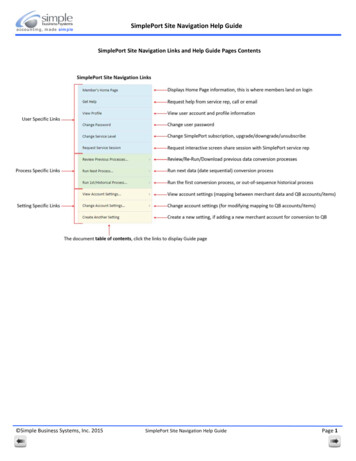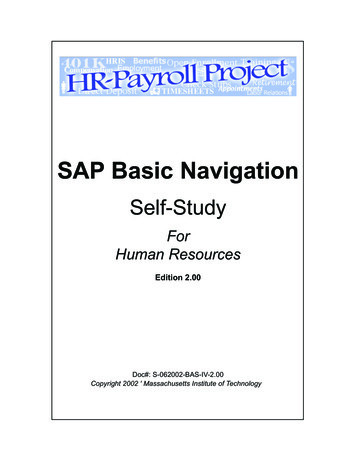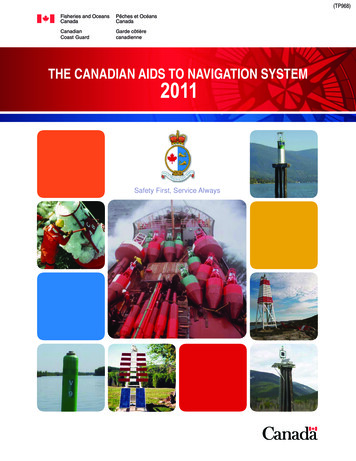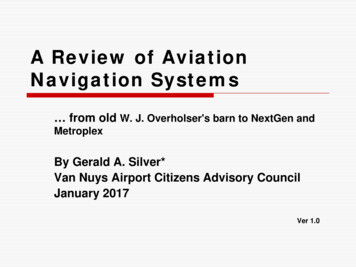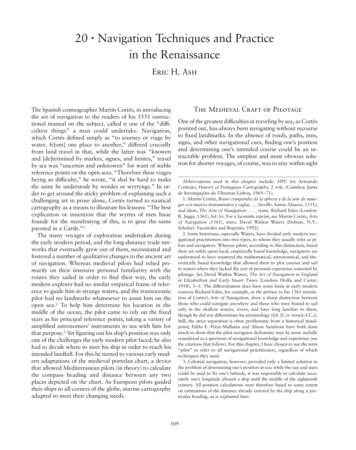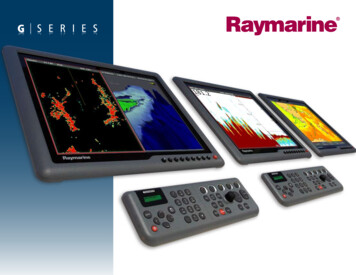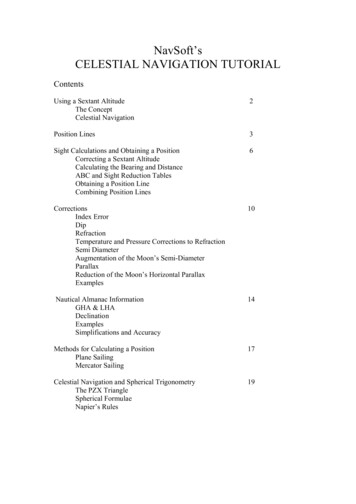
Transcription
NavSoft’sCELESTIAL NAVIGATION TUTORIALContentsUsing a Sextant AltitudeThe ConceptCelestial Navigation2Position Lines3Sight Calculations and Obtaining a PositionCorrecting a Sextant AltitudeCalculating the Bearing and DistanceABC and Sight Reduction TablesObtaining a Position LineCombining Position Lines6CorrectionsIndex ErrorDipRefractionTemperature and Pressure Corrections to RefractionSemi DiameterAugmentation of the Moon’s Semi-DiameterParallaxReduction of the Moon’s Horizontal ParallaxExamples10Nautical Almanac InformationGHA & LHADeclinationExamplesSimplifications and Accuracy14Methods for Calculating a PositionPlane SailingMercator Sailing17Celestial Navigation and Spherical TrigonometryThe PZX TriangleSpherical FormulaeNapier’s Rules19
The Concept of Using a Sextant AltitudeUsing the altitude of a celestial body is similar to using the altitude of a lighthouse orsimilar object of known height, to obtain a distance.One object or body provides a distance but the observer can be anywhere on a circleof that radius away from the object. At least two distances/ circles are necessary for aposition. (Three avoids ambiguity.)In practice, only that part of the circle near an assumed position would be drawn.
Using a Sextant for Celestial NavigationAfter a few corrections, a sextant gives the true distance of a body if measured on animaginary sphere surrounding the earth.Using a Nautical Almanac to find the position of the body, the body’s position couldbe plotted on an appropriate chart and then a circle of the correct radius drawn aroundit. In practice the circles are usually thousands of miles in radius therefore distancesare calculated and compared with an estimate.Working on this sphere, the distance becomes [90 - Altitude.] The point on thesphere corresponding to the Observer is known as his Zenith.Position LinesBecause of the immense radius, the short length of interest can be considered astraight line.Comparing the observed distance to the body and the calculated distance from anassumed position provides the distance towards or away from the body. The bearingis found by calculation and then it can be a simple matter of marking the assumedposition on a chart, drawing a line in the direction of the body and marking off thedifference between the observed and calculated distances.The observed distance is known as the True Zenith Distance (TZD.) The valuebased on the assumed position is the Calculated Zenith Distance (CZD.) Thedifference between the two is known as the Intercept.The closest point on this circle is known as the Intercept Terminal Position (ITP)and the line representing the circle at that position is called a Position Line.Additional sights provide additional position lines that intersect to provide a Fix.
A Running FixA vessel is usually moving between sights therefore they are combined "on the run."The position line from a first sight must be moved to allow it to be combined withanother position line for a different time.A double-headed arrow identifies a Transferred Position Line.After a second sight has been calculated, its position line can be plotted and combinedwith the first to provide a fix.The shorter the “run” between the two observations, the more accurate will be thefinal result. This is why star sights are usually better than sun sights. The opportunityto obtain more position lines of different directions is an additional benefit.
Notes on Running FixesUnder normal conditions, one would expect an error of /- 0’.3 in the Position Lines.(This error is mainly due to the time recorded under practical conditions.) LandSurveyors achieve accuracy comparable to a GPS using more sophisticatedinstruments but the same calculations/ method.Final accuracy is obviously improved by taking more observations. Six star sights willtypically provide a fix within 0’.2 of the true position.Most people adopt some shortcuts in the interest of speed. These have a cost in termsof accuracy. The Sun's Total Correction Tables assume that the Sun's semi-diameter iseither 15'.9 or 16'.2. A Sun Sight in April (SD 16'.0) is immediately in error by 0'.2.Tables are rounded to the nearest 0'.1 which could introduce a cumulative error of0'05 for every item.With Star sights, the short interval between the first and last sight means that manypeople use a single position for all the sights and plot the results without allowing forthe vessel's movement. The error is larger than above, but quite acceptable in midocean.Before GPS and CalculatorsThe method used until the 1980s was the Haversine Formula and Log Tables. A fewcommercial navigators used Sight Reduction Tables but most preferred the longermethod in the interests of accuracy and flexibility.The Haversine formula is a rearrangement of the Cosine formula (above) substitutingHaversines for the Cosine terms. (Hav( ) ½ x [1 – Cos( ) ] ). This makes acalculation using logarithms slightly easier, as the terms are always positive.Hav(CZD) Hav(Lat difference Dec) Hav(LHA) x Cos(Lat) x Cos Dec)
Sight Calculations and obtaining a PositionThe stages to resolving a sight are;Correct the Sextant Altitude to find the true distance of the bodyCalculate the bearing and distance from an assumed positionUsing the difference in distances to obtain a Position LineFinally Position Lines are combined to provide a fix.Correcting a Sextant AltitudeAn explanation of the corrections is found in the next section under “Corrections to aSextant Altitude.” All of these, except Index Error, are found in Nautical Tables.Example for the SunSextant AltitudeIndex ErrorObserved AltitudeDipApparent AltitudeRefractionTrue AltitudeSemi-DiameterTrue Altitude31 22’.02’.031 24’.0-3’.031 21’.0- 1’.631 19’.416’.532 26’.890 00’.0True Zenith Distance 57 33’.2Assuming "Off the Arc"SubtractSubtractAdd for Lower LimbAltitudes of Stars do not need a Semi-Diameter correction while the Moon needsmore corrections. See examples at the end of the next section.Calculating the Bearing and DistancePositions for the observer and position lines can be plotted on a chart or calculated.The section on “Sailings” deals with mathematical calculations.The other terms in the following formulae are derived from a Nautical Almanac. (SeeNautical Almanac Information.)The formulae for calculating the distance of the body and its altitude areCos(Zenith Distance) Sin(Lat) x Sin(Dec) Cos(Lat) x Cos(Dec) x Cos(LHA)andTan(Azimuth) Sin(LHA)/ (Cos(Lat) x Tan(Dec) – Sin(Lat) x Cos(LHA))
These formulae can be used without further knowledge however the section on“Celestial Navigation Calculations” provides an introduction to sphericaltrigonometry.
ABC TablesABC tables are very easy to use and more than adequate for the bearing of a celestialbody.These tables avoid the need to use a calculator or Log tables but are based on theprevious formulae.These transpose the Azimuth formula so thatA Tan(Lat) / Tan(LHA)B Tan(Dec) / Sin(LHA)C Difference A B 1/ [Tan(Azimuth) x Cos(Lat) ]ABC Tables ExampleLatitude20 NDeclination45 SLHA30 ABC0.63 S2.00 S-------2.63 SOpposite to Latitude unless LHA 180 Same as DeclinationSame name; Sum. Different names; DifferenceThe C Table gives a bearing of 22 .0. The sign of C means that this bearing is south.It is west because the LHA is less than 180.The C result would normally be written as "S 22.0 W" or 202 .The effect of rounding ABC Tables’ values is negligible ( /- 0 1.) This is not true ofthe older Sight Reduction Tables where the calculated altitude is rounded to thenearest minute. Furthermore the need to use a plotting sheet with a rounded, estimatedposition provides considerable scope for inaccuracy. (Sight Reduction Tables wereknown as the Air Navigation Tables until 2003.)The author’s preferred manual method is to use a calculator for the Zenith Distanceand ABC tables for Azimuths. Without a calculator he would still use the Cosineformula but with log tables.
Obtaining a Position LineThe difference between the True (TZD) and Calculated (CZD) Zenith Distances is theIntercept.TRUE, TINY, TOWARDSIf the TZD is less than the CZD then the assumed position must be moved in thedirection of the body by the amount of the Intercept. This gives a position of thecorrect distance from the body. It is known as the Intercept Terminal Position or ITP.As the radius of the circle is normally very large, it is considered to be a straight linenear this point. A line at 90 to the direction of the body is the Position Line.Combining Position LinesA single Position Line must be combined with other observations for a fix. This canbe achieved using a plotting sheet and then transferring the ITP by the distance to thenext sight and redrawing the Transferred Position Line in the same direction as theoriginal.For Sun sights, it is more usual to calculate the ITP of a morning sight and thencalculate the transferred position for the Sun's Meridian Passage (Noon.) Thedifference between calculated and observed latitudes provides a longitude using“Plane Sailing.” With a little practice, this will be found to be a faster, not to mentionmore accurate method.For Star Sights, many people use a single position and then plot the Position Lineswithout allowing for the vessel's movement. This may appear a sloppy practice but afew miles error mid-ocean is usually irrelevant. Even if the position at sunset wasperfect, there is no guarantee that the position an hour later is within a mile. Indeedeven if the position agrees perfectly with a GPS position, there is no guarantee that anintervening military operation has not thrown the GPS position out let alone a fault inthe equipment/ aerial. “I am about here,” is a far safer assumption than “Mywheelhouse is/ was within 10m of this position.”
Corrections to a Sextant AltitudeIndex ErrorThis error can be found using the horizon. The sextant’s altitude is set to zero andthen the two images of the horizon are aligned. The Index Error can then be read off.If the sextant altitude reads high, the correction is subtractive and termed “On theArc.” “Off the Arc” is the opposite.After Index Error has been applied, the Sextant Altitude it is referred to as theObserved Altitude.Dip/ Height of EyeThe True Horizon is at 90 to the Earth’s gravitational field. It coincides with theapparent horizon at sea level. However the Apparent Horizon starts to dip below thehorizontal plane as the height of (the observer’s) eye increases.Dip includes an allowance for Refraction below the horizontal plane.The formulae are;Dip 0.97 x Square Root (Ht of Eye in feet)Dip 1.76 x Square Root (Ht of Eye in meters)Dip is subtracted from the Observed Altitude to give Apparent Altitude.RefractionThe deflection of light as it enters/ passes through the atmosphere is known asRefraction.Refraction is stable and therefore predictable above about 15 , below that one needsto consider the characteristics of the atmospheric layers through which the lightpasses at that time. (Taking the altitude of bodies at less than 15 is usually avoidedfor this reason.)For altitudes above 15 , a simplified formula is adequate ( 0’.02)Refraction 0.96/ Tan (Altitude)Refraction tables make assumptions on the layers for low altitudes and should betreated with caution. /- 2 is not uncommon at an altitude of 2 .Refraction is subtracted from the Apparent Altitude to obtain the True Altitude.
Temperature and Pressure Correction for RefractionThe correction for Refraction assumes a temperature of 10 C and pressure of1010mb. This may be modified for actual temperature and pressure. A temperaturedifference of 10 C will alter Refraction by 3% and a 10mb pressure difference willchange Refraction by 1%. (0’05 and 0’.02 for an altitude of 30 )The multiplier to correct for Temperature ( C) and Pressure (mb) Pressure/ 1010 * 283/ (Temperature 273)Semi-DiameterWhen measuring the altitudes of the Sun, Moon, Venus and Mars, it is usual to useeither the top (Upper Limb) or bottom (Lower Limb) of the body. This offset mustthen be removed before comparison with the calculated value.The angular diameter of a body depends on its distance from the Earth. Thus for theSun the Semi-Diameter varies between 16’.3 in January, when the Sun is closest and15’.7 in June when it is furthest away.For a lower limb observation, the Semi-Diameter should be added to the True altitude.Augmentation of the Moon’s Semi-DiameterThe Earth’s radius is about 1/ 60th of the distance to the Moon. The reduction indistance compared to when on the horizon, has a measurable effect on its size. Incontrast the Sun’s distance is 23,000 times the Earth’s radius and the effect isnegligible.Augmentation Sin (Altitude) x Horizontal ParallaxHorizontal Parallax is used in the formula as the lunar distance is not provided in aNautical Almanac.This correction is typically 0’.15 and should be added to the Moon’s Semi-Diameterbefore applying the Semi-Diameter to the True Altitude.
Parallax in AltitudeThe Parallax correction allows for the difference in the altitude measured on theEarth’s surface versus the altitude that would be measured at the centre of the Earth.The effect of parallax reduces with altitude. It is greatest when the body is at thehorizon (Horizontal Parallax) and declines to zero when the body is overhead.The effect is also proportional to the distance of the body. Thus the HorizontalParallax for the Moon is about 1 but only 0’.15 for the Sun. This correction must beincluded for the Moon but is usually ignored for the Sun. It can be significant forVenus and Mars, depending on their distance, but is always insignificant for Jupiterand Saturn. ( 0’.05)Sin (Horizontal Parallax) Earth’s Radius/ Distance of BodyAfter correcting for altitude, the correction is known as Parallax in Altitude.Parallax in Altitude Horizontal Parallax x Cos (Altitude)Parallax in Altitude should be added to the True Altitude.Reduction of the Moon’s Horizonta
be plotted on an appropriate chart and then a circle of the correct radius drawn around it. In practice the circles are usually thousands of miles in radius therefore distances are calculated and compared with an estimate. Working on this sphere, the distance becomes [90 - Altitude.] The point on the sphere corresponding to the Observer is known as his Zenith. Position Lines. Because of the .

![Unreal Engine 4 Tutorial Blueprint Tutorial [1] Basic .](/img/5/ue4-blueprints-tutorial-2018.jpg)
